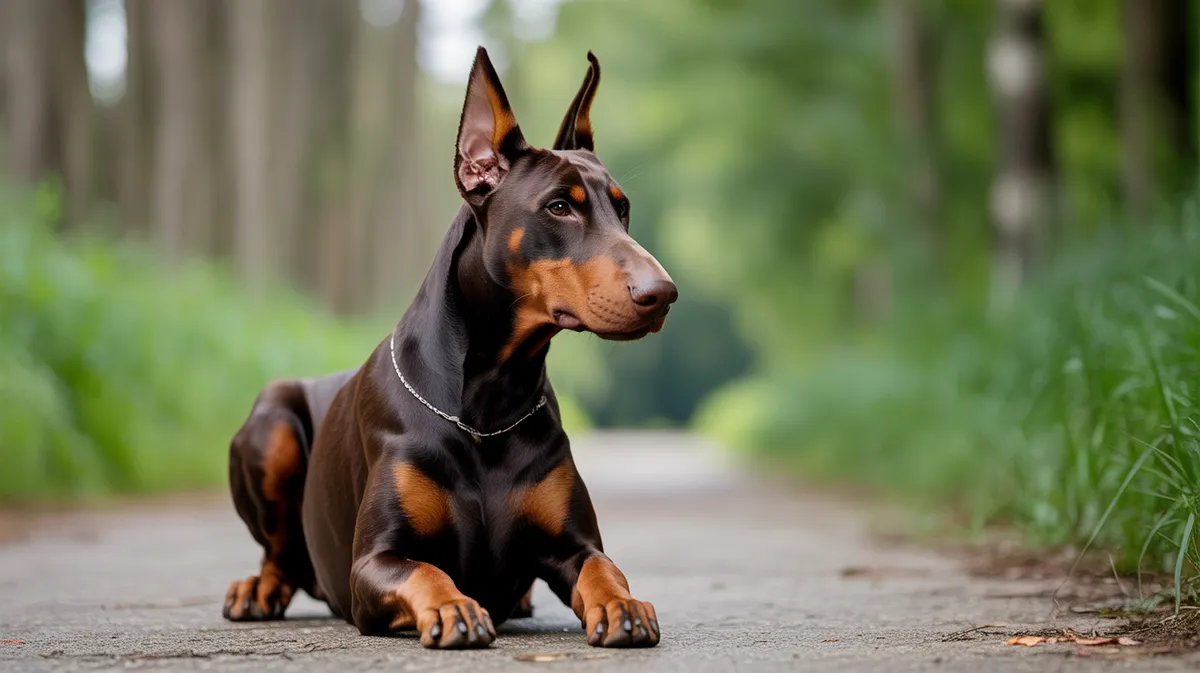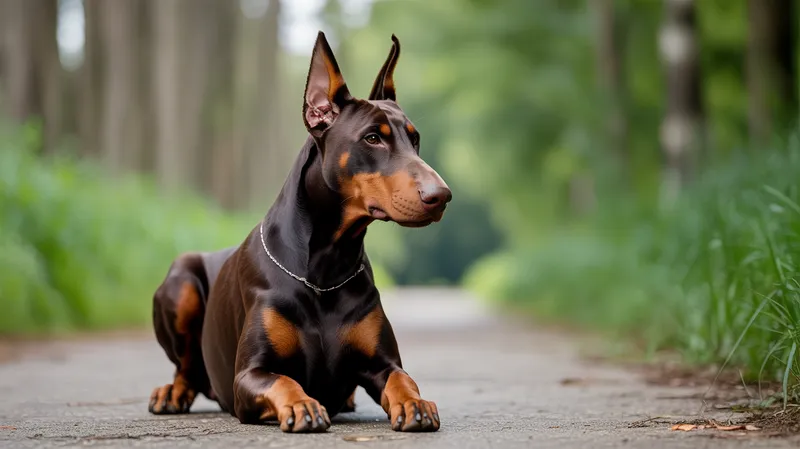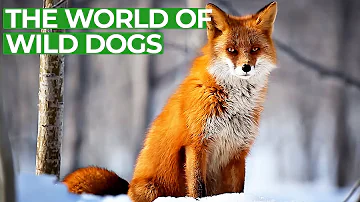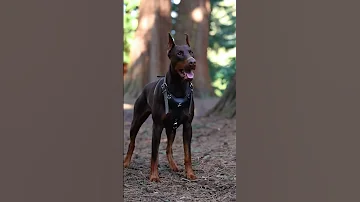
Doberman Pinscher
Canis lupus familiaris

Meet the Doberman Pinscher
The Doberman Pinscher is a medium to large domestic dog breed known for its sleek, muscular build and alert, intelligent demeanor. Developed in Germany during the late 19th century, Dobermans were originally bred as guard dogs and continue to be valued for their loyalty, courage, and protective instincts. They are highly trainable, energetic, and excel in a variety of roles including police, military, and search-and-rescue work. Despite their formidable appearance, Dobermans are affectionate with their families and can be gentle companions when properly socialized.
Classification
Mammal
Habitat
Domesticated; commonly kept in urban, suburban, and rural homes
Diet
Omnivore
Lifespan
10-13 years
Conservation
Least Concern
Weight
27-45 kg (60-99 lbs)
📖Fascinating Facts
Purpose-Bred Protector
The Doberman Pinscher was originally bred in Germany as a personal protection dog, specifically tailored to guard its owner.
Highly Intelligent
Dobermans are ranked among the most intelligent dog breeds and are quick learners, making them excellent working and service dogs.
Athletic and Agile
Known for their athleticism, Dobermans excel in dog sports such as agility, obedience, and tracking.
📋Detailed Description
The Doberman Pinscher is a robust, medium-large breed characterized by a sleek, athletic physique, deep chest, and a square, compact build. Adult males typically stand 68–72 cm (27–28 in) at the withers and weigh 40–45 kg (88–99 lbs), while females are slightly smaller. The breed's short, dense coat is most commonly black with rust markings, though blue, fawn, and red variants exist. Dobermans possess a long, wedge-shaped head with a pronounced stop, strong jaws, and a scissor bite. Their natural ears are medium-sized and folded, though cropping has historically been practiced for a more alert appearance. The tail is naturally long but often docked in countries where permitted. Dobermans are renowned for their intelligence, trainability, and keen senses, making them highly responsive to commands and quick learners. They exhibit a confident, alert demeanor and are known for their loyalty and strong protective instincts toward their family. Socially, Dobermans are generally affectionate with familiar people but may be reserved or aloof with strangers. They require regular mental and physical stimulation, thriving in environments where they are given purposeful activities and close companionship. The breed matures rapidly, reaching full physical and behavioral maturity by 18–24 months. Lifespan averages 10–13 years, with some individuals living longer under optimal care.
💡 Did you know?
Dobermans are one of the few breeds specifically engineered for personal protection, blending several breeds to optimize loyalty, speed, and intelligence.
🔬Research & Sources
Wikipedia Summary
The Dobermann is a German breed of medium-large working dog of pinscher type. It was originally bred in Thuringia in about 1890 by Louis Dobermann, a tax collector. It has a long muzzle and – ideally – an even and graceful gait. The ears were traditionally cropped and the tail docked, practices which are now illegal in many countries.
Last Modified: 5/26/2025
🎭Behavior & Social Structure
Doberman Pinschers are highly energetic and require significant daily exercise, including brisk walks, running, and interactive play. They are known for their vigilance and territorial behavior, often acting as natural guardians of their home and family. Socialization from an early age is crucial to prevent overprotectiveness or aggression toward unfamiliar people or animals. Dobermans form strong bonds with their owners and can suffer from separation anxiety if left alone for extended periods. They are highly intelligent and excel in obedience, agility, scent work, and protection sports. Feeding behavior is typical of domestic dogs; they thrive on a balanced, high-protein diet and may be prone to food allergies or sensitivities. Dobermans are generally not predatory but may display chasing behavior toward small animals if not properly trained. Their daily routines benefit from structure and consistency, and they respond well to positive reinforcement training methods.
👶Reproduction & Life Cycle
Doberman Pinschers are monoestrous, with females typically coming into heat twice per year. The optimal breeding age is between 2 and 6 years. Gestation lasts approximately 63 days, after which litters of 6–10 puppies are common. Responsible breeders screen for genetic disorders such as dilated cardiomyopathy and von Willebrand's disease prior to mating. Parental care is primarily provided by the dam, who nurses and tends to the puppies for the first 3–4 weeks. Puppies are weaned around 4–6 weeks and begin socialization and basic training soon after. Early socialization is critical to ensure stable adult temperaments. Breeding seasons are not strictly defined, as domestic dogs can breed year-round, but reputable breeders often plan litters to avoid extreme weather conditions.
🛡️Adaptations & Survival
Physically, Dobermans are adapted for speed, agility, and endurance, with long, powerful limbs and a deep chest for efficient oxygen exchange. Their short, close-lying coat allows for heat dissipation during vigorous activity but offers limited protection against cold, making them less suited to harsh climates without shelter. Behaviorally, Dobermans exhibit heightened vigilance and a strong startle response, traits selected for in their original role as guard and protection dogs. Their intelligence and problem-solving abilities are among the highest in canine breeds, facilitating complex tasks and rapid learning. The breed's strong social drive and loyalty are evolutionary adaptations for cooperative work with humans.
📚Research Sources
🎨Cultural Significance
Doberman Pinschers have played significant roles in military and police work worldwide, notably serving as messenger and sentry dogs during World War II. Their image as loyal protectors has made them popular in film, literature, and as symbols of strength and vigilance. In some cultures, the Doberman is associated with nobility and guardianship. The breed's name honors its creator, Karl Friedrich Louis Dobermann, a German tax collector who sought a reliable personal protection dog. Dobermans are also valued as therapy and service animals due to their intelligence and trainability.
🔬Recent Research & Discoveries
Recent genetic studies have identified specific mutations associated with dilated cardiomyopathy in Dobermans, leading to improved screening and breeding recommendations. Behavioral research has highlighted the breed's high cognitive abilities and responsiveness to human cues. Ongoing studies focus on optimizing training methods for working and service roles, as well as investigating the impact of early socialization on adult temperament. The Doberman Diversity Project is a notable initiative aimed at increasing genetic diversity and reducing inherited health issues within the breed.
🎥Wildlife Videos

Wildlife - Just Wild Dogs | Free Documentary Nature
Wildlife - Episode 7: Just Wild Dogs | Wildlife Documentary Watch 'Wildlife - Episode 8' here: https://youtu.be/kglJpB4ei8o Run ...
Free Documentary - Nature

Wildlife Stories: Love is in the Wild | SPECIAL | Free Documentary Nature
Wildlife Stories: Love is in the Wild | Special | Free Documentary Nature Watch 'Wildlife Stories: Talking to Survive' here: ...
Free Documentary - Nature

Doberman Pinscher
Doberman Pinscher in the United States and Canada, is a medium-large breed of domestic dog that was originally developed ...
NatureTV

Doberman vs Tiger – Who will Win 😎
Doberman vs Tiger – Who will Win.
Chasing tail

David Attenborough presents: Wild City Singapore | Full Series | Free Documentary Nature
David Attenborough presents: Wild City Singapore - Full Series | Wildlife Documentary Watch 'David Attenborough Presents: ...
Free Documentary - Nature

THE DOBERMAN - FULLY TRAINED PROTECTION DOG
The Doberman is revered as one of the world's most lethal protection dogs, with incredible trainability, intelligence and affection ...
Animal Watch
🌍Habitat Information
The Doberman Pinscher typically inhabits Domesticated; commonly kept in urban, suburban, and rural homes environments. Doberman Pinschers have adapted to their environments with specialized features and behaviors.
Primary Habitat:
Domesticated; commonly kept in urban, suburban, and rural homes
More detailed habitat information will be available soon.
🛡️Conservation Status
The Doberman Pinscher is currently classified as Least Concern. Conservation efforts are crucial for preserving this species for future generations.
Common Threats:
- 🏠Habitat loss and fragmentation
- 🌡️Climate change impacts
- 🎯Hunting and poaching
- 🏭Human-wildlife conflict
⚠️Threats & Conservation Challenges
While the Doberman Pinscher is not at risk in terms of population, the breed faces several health challenges, including a high prevalence of genetic conditions such as dilated cardiomyopathy, von Willebrand's disease, and cervical vertebral instability (Wobbler syndrome). In some regions, breed-specific legislation restricts or bans ownership due to concerns about aggression, often based on misconceptions. Overbreeding and irresponsible breeding practices have contributed to health and temperament issues. The decline of tail docking and ear cropping, now illegal in many countries, has shifted breed standards and public perception. Population trends remain stable globally, but ethical breeding and health screening are ongoing concerns.
🔬Scientific Classification
Scientific Name
Canis lupus familiaris
Classification Hierarchy
🔍 About Taxonomic Classification
Taxonomic classification is a hierarchical system used by scientists to classify and organize living organisms based on shared characteristics and evolutionary relationships.
The system moves from broad categories (Kingdom) to increasingly specific ones, with each animal's scientific name typically consisting of its Genus and species.
📝Community Notes
Share your observations and insights about the Doberman Pinscher with our community of wildlife enthusiasts.
Join Our Community
Sign in to share your observations and connect with fellow wildlife enthusiasts.
Sign In to ContributeNo community notes yet
Be the first to share your observations about the Doberman Pinscher!
Explore Doberman Pinscher
Select a tab above to learn more about this amazing animal.
📸Photo Gallery
No photos available for this animal yet.
🌟Discover More Wildlife
Continue your journey of discovery with more fascinating animals from our database
